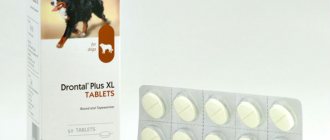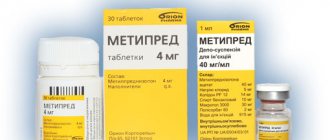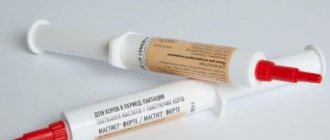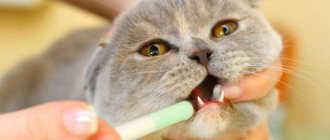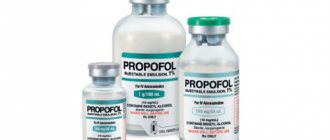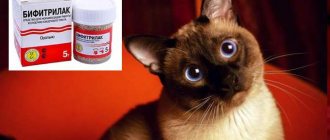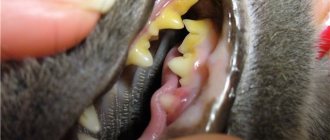Deficiency and consequences
At each stage of life, a cat should receive the required amount of calcium appropriate to its age and needs. Without calcium, processes such as the transmission of nerve impulses and muscle contraction are not possible.
Proper calcium intake – in the right amount and at the optimal period. If a cat lacks a microelement, this immediately affects its health, and the consequences are different at each age. For example, if a kitten lacks calcium, then the situation is aggravated by pathologies in skeletal development. Lack of calcium in a cat in adulthood and old age leads to brittle bones - the possibility of fractures increases. Adult pets feel a lack of this element in the fifth month - that is, five months after the body experiences a shortage. In kittens this happens much faster.
It also happens that a cat has high calcium - what to do in this case? Of course, stop giving your cat calcium. It should be remembered that pets at different periods of life require an increased rate of this microelement - especially at a young age, during lactation. Excessive calcium content in a cat’s body is fraught with bone pathology and osteochondrosis.
It is important to adhere to the consumption norm. Is your cat lacking calcium? Use an approximate calculation of consumption - only a veterinarian will provide more accurate information.
- kittens - 440 mg per 1 kg of weight ;
— adult cats – 45 mg per 1 kg of weight .
For example, an adult cat weighing 4 kg should receive 180 mg of calcium per day .
CALCIUM IN YOUR CAT'S LIFE.
Lee Harper, translation by M. Zheltovskaya
At the very beginning of my passion for cats, I witnessed a discussion between breeders on the topic of whether to give extra calcium to add strength to the cat during childbirth. I listened very carefully when one breeder told how his cat gave birth to a large litter. After the birth of four kittens, the mother suddenly began to breathe very quickly and frequently. Suddenly she found herself weak and powerless. The breeder administered Calcium Gluconate to her. It worked like a miracle; within 15 minutes the cat regained her strength and gave birth to four more healthy kittens. At the end of the birth, the breeder gave her another dose of Calcium Gluconate and another dose three days later. This interested me very much. And I wanted to get to the bottom of what happened to the cat? When I researched in more detail the protocols for prescribing Calcium tablets or injections for cats during obstetrics, I discovered some interesting facts. Veterinarians often give calcium injections at the same time as oxytocin because it is believed that the cat needs sufficient levels of calcium for oxytocin to work. My personal veterinarian cautions, however, against unnecessarily adding calcium to a pregnant, laboring, or lactating cat.
Testing your blood calcium levels
She recommends doing this before prescribing an additional dose of the drug, whenever possible. There are two reasons why she prefers to know the level of calcium in the animal's blood. First, giving too much calcium when it is not needed can lead to acute and serious kidney failure. And second, knowing your cat's blood calcium levels helps predict whether a given cat is predisposed to low blood calcium levels during future pregnancies and kittens.
Calcium injections.
A cat that has low blood calcium can be given Calcium Gluconate or Cal-Pho-Sol to quickly increase its level. For an average cat, 10 ml of Calcium Gluconate subcutaneously is sufficient if her uterine contractions (contractions) stop during labor. As a rule, contractions resume within 20 minutes. Some veterinarians will also prescribe 2 ml of vitamin B-complex to help relieve the stress your cat experiences during this period.
Calcium tablets.
Some breeders give cats calcium tablets, or calcium supplements, or even sometimes add crushed chalk to their cat's favorite food. Sometimes Caullophyllum is used, which can be purchased at a regular grocery store. It is given in the last half of pregnancy to improve the tone of the uterus. Give your cat one dose twice a week. If the cat is having problems during labor, it is recommended to give one dose every 15 minutes, up to a maximum of 4 doses.
Attention.
Be extremely careful when giving your cat extra calcium on your own.
And if you are giving your cat calcium during labor in response to her weakened labor, remember that it is not just
low calcium levels in the blood that may be causing the problem. You can waste valuable time if you mistakenly wait for the calcium to start working.
Eclampsia.
No discussion of the need to add calcium to a cat's diet would be complete without mentioning Eclampsia. Sometimes in the initial stages of nursing, a cat suffers from a decrease in serum calcium levels, which are washed out of her body due to milk production. The so-called Eclampsia, or Milk fever, is characterized by increased agitation, refusal to eat, and also refusal to feed kittens. There is profuse drooling, incoordination of movements, and convulsive twitching. As the condition worsens, the cat falls on its side, convulsions develop, the temperature rises sharply, and the level of calcium in the blood decreases, which leads to the rapid death of the animal.
IMMEDIATELY
call your veterinarian! In this case, intravenous administration of Gluconate or Calcium Chloride is mandatory. In severe cases, kittens should be removed from their mother and either bottle-fed or, if possible, placed with another nursing cat.
PS When a professional veterinarian read this article, she noticed that not all medications that American breeders use, we have the opportunity to use for our cats in Russia. I asked her to adapt the recommendations given in Lee Harper's article for Russian conditions. Now you can read the opinion of our practicing veterinarian about the problem of calcium balance in the cat’s body and ways to solve it. I hope this detailed article will help you take better care of your cat's health and be prepared during and after birth, when your cat is at her most vulnerable.
Calcium ions play an important role in the passage of signals along nerve endings-axons, i.e. in the conductivity of nervous tissue. Without them this is impossible. During pregnancy, the body spends a large amount of labile calcium (calcium circulating in the bloodstream) to build the bodies of the fetuses, and in the last days of pregnancy also for milk production. If it is not enough, the mother’s body uses stable calcium, i.e. calcium found in bones. Calcium is washed out of the bones. In this situation, there may not be enough calcium ions necessary to ensure that the signal of sufficient strength passes into the uterus. And the latter contracts sluggishly or does not contract at all. Why should she work if there is no team? In such a situation, oxytocin is useless - the woman in labor does not respond to it at all.
This situation occurs not only in poorly fed or malnourished cats, but also in the fattest, purebred and beloved ones. It is especially common with a large number of kittens. A cat can easily give birth to her first kitten and then nap for 3-4 hours or have infrequent and weak labors. In this case, you can safely take 1 ml of 10% calcium gluconate solution deeply intramuscularly. 2-3 such injections during labor with an interval of 2-3 hours will not cause any harm to the cat. A large dose can cause cardiac shortness of breath - excess calcium ions disrupts the conductivity of the heart muscle and interferes with its proper functioning. Moreover, these phenomena occur several hours after administration of an increased dose.
Calcium gluconate is very effective in labor that is not complicated by abnormal fetal position or discrepancy between the size of the fetus and the pelvic inlet. It causes active, strong efforts, quickly leading to the expulsion of the fetus.
Against the background of calcium, oxytocin can also be used in normal doses, but at intervals of 30 minutes after injection of 10% calcium gluconate. In this case, minor problems may arise. Although they occur quite rarely, they are important to be aware of. Even when the uterus is completely freed from the fetuses, it continues to actively contract for some time (sometimes several hours). Most often this happens when oxytocin is used together with 5% glucose solution. But these phenomena disappear on their own within a few hours.
Subcutaneous injection of 0.3 ml of oxytocin + 5 ml of 5% glucose is very effective, but it is advisable to use it when the last fetus is expelled. This is too much of a shock for the uterus and after it it can rest for up to 12 hours. Therefore, it is better to make sure that the kitten is the last one in the uterus, and only after that inject oxytocin on glucose.
The use of calcium for eclampsia is recommended by a veterinarian and in each case individually, but the average dose is 1 ml of 10% calcium gluconate every 40 minutes until the manifestations of eclampsia cease. In parallel with calcium gluconate, no-spa 0.3 ml is injected once and prednisolone 0.5 ml is injected once. Next, the animal is transferred to a maintenance dose of 1 ml 2 times a day for 7-10 days and then calcium is given in any form orally until the end of milk production.
By the way, the manifestations of eclampsia in cats are different and can be either in the form of increased excitability - convulsions, trembling, failure to recognize the owners and their kittens with jumping up to the ceiling, or in the form of inhibition - central nervous system apathy, lethargy, weakness of the hind limbs. Often, with eclampsia, a cat walks on straight hind legs, as if on stilts; the joints of the hind limbs almost do not bend due to muscle spasm. And a temperature of 40-41 degrees is also a sure companion of eclampsia. As a rule, the same animals suffer from eclampsia, and cats that have had this “charm” at least once should have a longer interval between pregnancies (a cat is not a machine for dispensing chocolates - press buttons every 5 minutes) and a diet with a high calcium content. All this is true for dogs, but taking into account their greater weight.
Svetlana Stenina
, practicing veterinarian.
==========================================================================
From the forum:
Treatment. Postpartum tetany is a real danger. Call your doctor home immediately! The cat needs complete rest! Place it away from light sources, no noise, no sharp sounds! At the first signs of the disease, calcium gluconate is administered intravenously to restore its normal level. If the rectal temperature is above 40°C, then before the doctor arrives, treatment is carried out, as for heat stroke. You can administer calcium intramuscularly before the doctor arrives. For eclampsia, the dose of calcium in each case can be individual and determined by a veterinarian. But, the average and safe dose is considered to be intramuscular (deep) administration of 1 ml of 10% calcium gluconate every 40 minutes until the symptoms of eclampsia cease. In parallel with calcium gluconate, no-spa 0.3 ml is injected once and prednisolone 0.5 ml is injected once. Next, the animal is transferred to a maintenance dose of 1 ml 2 times a day for 7-10 days and then calcium is given in any form orally until the end of milk production. Kittens are weaned for 24 hours and artificially fed. Restoration of lactation and breastfeeding depends on the mother's response to treatment and the age of the kittens. If they are 3 weeks old, they are weaned from their mother. If the kittens are less than 3 weeks old, they can be placed with their mother after she has fully recovered. On the first day, kittens are allowed to nurse 2-3 times a day for no more than 30 minutes per feeding. In the following days, gradually increase the time of breastfeeding and after 48 hours they begin to feed as usual. During this period of time, kittens need complementary feeding, and the cat is given additional calcium, phosphorus and vitamin D.
As a rule, the same cats suffer from eclampsia, especially those that have been exposed to this test at least once. Therefore, they should have a significantly longer interval between pregnancies, as well as a diet high in calcium.
===================================================================
Calcium gluconate
Chemical name:
Calcium salt of gluconic acid
Composition and release form:
Active substance - calcium gluconate. Aqueous 10% solution of calcium gluconate for injection 5 or 10 ml in ampoules of 50 pcs in folding boxes.
Pharmachologic effect:
The effect of calcium ions on the body is antagonistic to the effects of magnesium, sodium and potassium ions. The biological involvement of calcium in cardiac activity favors systolic contraction. Calcium reduces cell permeability and plays an important role in blood coagulation and in the regeneration of lactacytogen from its decomposition products during muscle work. It prevents the development of inflammatory processes due to its sealing effect on the walls of blood vessels. Calcium also favors increased tissue resistance to infections and can significantly enhance phagocytosis. It has been observed that phagocytosis, which decreases after taking sodium chloride, increases after taking calcium. Calcium gluconate has an antiallergic effect and a weak central sedative effect.
Indications:
Pregnancy, lactation, period of increased body growth: bleeding of various etiologies; symptoms of anaphylaxis (serum sickness, urticaria, itching, Quincke's edema); bronchial asthma, dystrophic alimentary edema, spasmophilia, tetany, pulmonary tuberculosis, rickets and osteomalacia, lead colic.
Side effect:
Extremely rare - allergic reactions.
Nausea, vomiting, diarrhea , bradycardia.
When administered intravenously, there is a burning sensation in the mouth, heat throughout the body. When administered intramuscularly - necrosis. Contraindications:
Hypercalcemia, hypercoagulation, atherosclerosis. A relative contraindication for parenteral administration is taking digitalis preparations.
===================================================================
INSTRUCTIONS
on the use of Catosal to stimulate metabolic processes and nonspecific resistance in animals
(organization-/Bayer HealthCare LLC, USA)
I. GENERAL INFORMATION
1. Catosal.
2. Catozal is a complex medicine containing in 100 ml: butophosphamide (10 g), cyanocobalamin (0.005 g), methyl 4-hydroxybenzoate (0.1 g), as well as water for injection.
3. In appearance, the drug is a transparent pink liquid.
4. Catozal is produced in the form of a sterile 10% solution, packaged in 100 ml in hermetically sealed glass bottles, placed in individual cardboard boxes.
The bottle and box are marked in Russian with the manufacturer's organization, its address and trademark, the name, purpose and composition of the drug, the amount of the drug in the bottle, the method of use, the batch number, the date of manufacture, the expiration date, storage conditions, the inscription “For animals” ", "Sterile" and provide instructions for use.
Store the drug in a dry place, protected from light, at a temperature of 5 to 25 ° C.
The shelf life of the drug, subject to storage conditions, is 5 years from the date of manufacture.
Catozal should not be used after the expiration date.
II. PHARMACOLOGICAL PROPERTIES
5. Catozal has tonic properties, normalizes metabolic and regenerative processes, has a stimulating effect on protein, carbohydrate and fat metabolism, increases the body's resistance to adverse environmental factors, and promotes the growth and development of animals.
6. In terms of the degree of impact on the body, Catozal belongs to low-hazard substances (hazard class 4 according to GOST 12.1.007-76), in recommended doses it does not have locally irritating, sensitizing, embryotoxic, teratogenic, mutagenic and carcinogenic effects, and does not have cumulative properties.
III. ORDER OF APPLICATION
7. Catozal is prescribed to large and small cattle, horses, pigs, dogs, cats, fur-bearing animals and chickens for metabolic disorders of various etiologies, and also as a stimulant and tonic:
- to increase the body's resistance to diseases of various etiologies;
- as an additional remedy in the treatment of diseases caused by deficiency of calcium and magnesium in the body;
- during childbirth, as well as for the prevention of postpartum complications (tetany, maternity paresis);
- during heavy physical exertion and increased physical activity in sports horses (2 – 3 days before the competition).
8. Catozal is used for large and small cattle, horses, pigs, dogs, cats and fur-bearing animals once a day intramuscularly, subcutaneously or intravenously (slowly), for poultry - orally with drinking water for 4 - 5 days, in single doses, indicated in the table.
Table
Kind of animal
| Dose (ml per animal) | |
| Adult horses and cattle | 10 – 25 |
| Foals, calves | 5 – 12 |
| Adult sheep and goats | 2,5 – 8 |
| Lambs, kids | 1,5 – 2,5 |
| Adult pigs | 2,5 – 10 |
| Suckling piglets, gilts | 1 – 2,5 |
| Laying hens, broilers | 2 – 3 ml per 1 liter of drinking water |
| Chickens, replacement young stock | 1 – 1.5 ml per 1 liter of drinking water |
| Dogs | 0,5 – 5 |
| Cats, fur animals | 0,5 – 2,5 |
9. In the chronic course of the disease, 1/2 of the dose of Catozal indicated in the table is prescribed. A repeated course of treatment, if necessary, is carried out at intervals of 5–14 days.
10. Katozal does not replace or exclude the use of antibacterial and other means of etiotropic therapy.
11. There are no side effects or complications when using Catozal in accordance with these instructions, no contraindications have been established.
12. The slaughter of animals for meat and the use of meat, milk and eggs for food purposes during and after the use of Catozal is permitted on a general basis.
IV. PRECAUTIONARY MEASURES
13. When working with the drug, you should follow the general rules of personal hygiene and safety precautions provided for when working with medicinal products for animals.
14. Catozal should be stored in places inaccessible to children and animals.
The instructions were developed (Germany) jointly with Bayer JSC (Moscow)
Organization-; 12707 Shawnee Mission Parkway Shawnee, Kansas 66201-0390 USA
Recommended for registration in the Russian Federation by the Federal State Institution "VGNKI"
Registration number PVI-2-0.2/01071
Head of Department
animal health protection
Bayer JSC R. Gebauer
==========================================================================
OXYTOCIN (Oxytocinum).
Oxytocin is a peptide hormone (octapeptide) of the posterior pituitary gland. Consists of a pentapeptide cycle and a side chain of three amino acid residues. The cycle is formed in such a way that two cysteine groups (at positions 1 and 6), closing, create a disulfide bridge. Currently, oxytocin is produced synthetically. Synonyms: Syntocinon, Ipofamin, Ocytocin, Orasthin, Oxystin, Oxytocin, Partocon, Pitocin, Pitupartin, Synpitan, Syntocinon, Utedrin, Uteracon, etc. The main pharmacological property of oxytocin is the ability to cause strong contractions of the muscles of the uterus, especially during pregnancy. This action is associated with the effect of oxytocin on the membranes of myometrial cells; it does not have a direct effect on the contractile elements of the myoplasm. Under the influence of oxytocin, the permeability of the membrane for potassium ions increases, its potential decreases and excitability increases. Oxytocin also increases milk secretion by enhancing the production of the lactogenic hormone of the anterior pituitary gland (prolactin). In addition, it can cause rapid release (throwing out) of milk from the mammary gland due to the effect on its contractile elements. In terms of its effect on the uterus, synthetic oxytocin is similar to natural preparations of the posterior lobe of the pituitary gland (pituitrin, hyfotocin). Due to the fact that oxytocin is free from other hormones, it has a more selective effect and gives only a weak antidiuretic effect; does not significantly affect blood pressure or slightly increases it. Since the drug is free from proteins, peptides and other by-products, it can be administered intravenously without the danger of anaphylactic and pyrogenic effects. Used to induce and stimulate labor. The drug is most effective for premature rupture of amniotic fluid. It is also prescribed for weakness of labor associated with uterine atony and hypotonic uterine bleeding. Can be used to artificially induce labor (in case of pregnancy complications). Administered intravenously or intramuscularly. Intravenous administration causes a rapid (in 1/2 - 1 min) intensification of contractions; weak contractions become stronger, and in the absence of contractions they usually appear quickly. Intramuscular administration has a less dramatic effect. Oxytocin should be used under medical supervision. Individual sensitivity to oxytocin must be taken into account. Oxytocin for inducing labor is contraindicated in cases of discrepancy between the sizes of the pelvis and the fetus, transverse and oblique position of the fetus, threatening uterine rupture, and the presence of scars on the uterus after a previous cesarean section. Oxytocin is also used for the prevention and treatment of hypotonic uterine bleeding. In case of prolonged labor, accompanied by weakness of labor and overstretching of the uterus, the placenta is administered immediately after birth or its manual separation intramuscularly. Oxytocin is recommended during caesarean section. Release form: in ampoules of 1 or 2 ml containing 5 or 10 units of oxytocin. Storage: List B. In a cool, dark place. When using oxytocin, syringes must be freed from residual alcohol (rinse with water for injection).
===============================================================================
And also an excellent drug: CALFOSET!!!
(personally, I use this drug constantly, as a preventive measure)
Sources of calcium for cats
If pets are naturally fed, it is important for the owner to consider where they will get calcium from. As for meat, this is a controversial source of calcium, because most of the phosphorus enters the body with it - but the cat receives very little calcium from meat. It is important to consider the ratio of phosphorus and calcium in the diet. The norm for adults is 1:1.2 or 1:1 . For kittens – 1:1.4 . To the question “ can cats have calcium? ” there is only one answer – it is necessary , and regularly . If, when fed with balanced food, the cat receives its daily requirement - calcium in cat food is necessarily taken into account, then with a natural type of nutrition, all responsibility falls on the shoulders of the owner - it is he who chooses the source of calcium for the pet.
It should also be noted that calcium is not absorbed by cats from foods of plant origin - we have to look for alternative options.
Bone and meat and bone meal
Many owners, having read that calcium can be taken from bone or meat and bone meal, choose such a dietary supplement for their pet. But let's figure out whether it is necessary to do this and is it safe?
Bone meal (the chemical formula for calcium is Ca10(PO4)6(OH)2, which is calcium hydroxyapatite, as in regular bones) is a powder made from the ground up bones of domestic animals and is used primarily as a plant fertilizer. Meat and bone meal is used as animal feed. It is obtained from the carcasses of animals not suitable for human consumption. This is mainly carrion, waste from meat and fish production. The raw materials are steamed or boiled, then dried and crushed. The final mixture consists of protein, ash, fat and a very small amount of water (within 7%).
The conditions for preparing meat and bone meal involve processing under pressure at an elevated temperature of at least 130 degrees Celsius. Under such conditions, proteins denature (they lose their original structure and properties). This is done for the sake of disinfection and long-term storage. But high temperatures make proteins much less valuable. Likewise, calcium from such raw materials is poorly absorbed.
In addition, in this flour the ratio of calcium and phosphorus is 1:1, which means that the overall balance of these elements in the diet will be disrupted due to meat and bone meal.
Conclusion: it is better not to use this product when trying to find calcium for a cat.
Bones and meat
Meaty bones are a traditional way for cats to obtain calcium. But in this case, you must adhere to certain rules, otherwise you cannot avoid intestinal blockage or other, more serious problems.
However, everyone knows the experience of wild cats - they catch mice and birds, eating them completely - with bones, thereby replenishing the calcium level in the body. Owners feed their tailed pets selectively - mostly boneless meat. So should you give your cat bones?
Bone products are an excellent source of collagen, calcium, chondroitin, and glucosamine.
— Do not give your cat sharp bones, which can injure the intestines and lead to internal bleeding. These are the tubular bones of the wings and legs.
- Cats should not be given medium or large bones - these will get stuck in the esophagus or throat.
- Choose suitable bones with meat from the whole carcass. Alternatively, grind the selected parts in a meat grinder or break into small pieces with a hammer.
— Do not give your cat bones that have undergone heat treatment. When boiling or frying, the chemical composition of the bone changes: protein, vitamins and fat go into the broth, and calcium phosphate loses its digestibility.
Compatibility with other drugs
Calcium borgluconate is incompatible with the following substances and drugs:
Carbonates (Calcium Carbonate), salicylates (Sodium salicylate, Acelysin, Salicylamide), sulfates (magnesium or sodium sulfate, Sulf 120, Streptomycin sulfate). They cause the formation of insoluble salts.
Tetracyclines (antibiotics) – Doxycycline, Tetracycline, Minolexin, Rondomycin. They also lead to the formation of insoluble compounds.
Cardiac glycosides – Digoxin, Korglykon, Gitalen, Adoniside, tincture of lily of the valley. The danger of joint use is an increase in the toxic effect of glycosides.
Incompatibility with drugs must be taken into account, since complications or new diseases may arise.
Vitamins with calcium
Veterinary pharmacies offer a large number of calcium preparations for cats. Their selection is carried out in accordance with certain rules:
- do not give drugs “by eye” or for a long time - hypervitaminosis is even worse than a lack of vitamins. Do not ignore the instructions and rules for taking vitamins;
- if the cat eats raw boneless meat, purchase vitamin complexes without phosphorus;
- before constantly taking any drug with calcium, make sure there are no allergic reactions - monitor your pet’s health;
- if the pet is on a special professional food, then it contains all the Vitamins that cats need - taking additional supplements is discussed only with a veterinarian.
Side effects
Side effects are associated with the method of injecting the solution. If it was performed subcutaneously, redness and itching may form at the injection site. Symptoms usually go away without outside intervention. Rapid injection into a vein is dangerous due to a sharp drop in pressure, slowing of the pulse, and cardiac arrest.
Contraindications
Contraindications to the use of calcium in the form of borogluconate:
increased level of calcium ions in the blood;
active blood clotting;
digestive disorders (diarrhea);
weakening after illness, surgery;
disorders of the kidneys.
If any contraindication is detected, calcium borgluconate is recommended to be changed to another drug.
Overdose
Symptoms of exceeding the therapeutic dose:
slowing heart rate, lowering blood pressure, irregular heartbeat;
excess calcium and its salts.
In case of intense symptoms, calcitonin is administered into a vein.
Calcium supplements for cats
There are several common calcium compounds found in vitamin and mineral supplements for cats.
Calcium carbonate
This compound is found in egg shells and is also found in chalk and shells. Its digestibility is 20% , in addition, side effects are possible with excessive consumption of the supplement. It is better to exclude calcium carbonate from possible options and not consider this calcium requirement for cats.
Calcium gluconate
This is the most famous compound in Russia, but, unfortunately, only 3% . As a vitamin supplement, it is better for cats to replace calcium gluconate with a more suitable option.
Calcium lactate
This is a good calcium compound for kittens up to three months of age, who are still digesting lactose - unlike adult cats. Lactate is contraindicated for cats older than three months - it causes digestive problems.
Calcium citrate
A suitable compound as a vitamin-mineral complex for cats. Digestibility is 44% . This figure is small, but still higher than in the case of calcium carbonate and calcium gluconate. The advantage of use is the low price and the absence of side effects from taking it even if the dosage is exceeded. In the case of calcium gluconate, it is much more difficult to calculate the dosage for a cat.
For dogs and cats, calcium citrate is an optimal dietary supplement.
Calcium chelate
The leader in the digestibility rating is calcium chelate. It is absorbed by the cat's body by 90-98% . This is facilitated by the presence of calcium molecules together with amino acids. With the previously described compounds, the body needs to do additional work - perform long chains of chemical reactions. The cost of the chelate is high, and it is also more difficult to find such an additive. But it's worth it!
Check the prices for vitamins for cat fur - such complexes should be given to cats in courses or on the recommendation of a veterinarian.
Feed additive tricalcium phosphate: instructions for use for dogs
TCP can have a good effect when used not only for farm animals, but also for domestic ones. Of course, in this case this premix is not used daily. Veterinarians prescribe it to dogs when the calcium-phosphorus balance in the body is disturbed. In this case, the dosage is determined by a specialist. But most often dogs are given 1 tsp. per day along with food until the balance normalizes.
Thus, we have found out what kind of additive this is - feed tricalcium phosphate. The instructions for using the premix make it clear that this drug can be used for each specific type of farm animal and poultry; of course, you should adhere to the doses indicated in the instructions.
Too much of this substance is usually not added to mash. The supplement costs only about 25-30 rubles per kilogram. So the farmer will not have to bear any special expenses when using it. The effect of using the premix (reducing morbidity and increasing the productivity of animals and poultry) will certainly manifest itself.
Vitamins for cats with calcium
When it comes to the health and longevity of furry pets, the responsibility falls on the owner - cats and dogs simply have no one else to rely on.
The best vitamins for cats with calcium are natural. Such supplements are balanced in composition and can guarantee good digestibility and effectiveness after a course of administration. In this case, it is completely safe to buy calcium for cats.
| Sea calcium - 1023 rub. | Eggshell powder - RUB 1,259 |
cdVet Fit-Barf Sea Calcium contains one valuable ingredient - limestone from seaweed. This is an excellent option for natural feeding of pets, as it neutralizes excess phosphorus in fresh meat. 100% natural composition guarantees good absorption of the vitamin supplement by cats. We also advise you to familiarize yourself with the prices of vitamins for joints for cats - the calcium content in such preparations is also required.
Fit-Barf Eggshell powder is a natural source of calcium, which fits perfectly into the diet of pets and replenishes the lack of calcium in the body.
| MicroMineral — 1336 rub. | ArthroGreen Classic — 2470 rub. |
Fit-Barf MicroMineral is a mineral feed additive containing seaweed, yeast, malt and grape seed extract. The plant origin of the components is valuable for the body of cats, who receive the supplement daily. They do not overload the detoxification organs - liver and kidneys.
Giving calcium oxalate to a cat is a less attractive idea; vitamins from natural ingredients are another matter.
Treatment of mastitis in animals
Mastitis is an inflammatory process in the udder area of an animal. The appearance of such changes is provoked by pathogenic factors, which are accompanied by pathological changes in the tissues and secretions of the mammary gland.
Subclinical mastitis is common among animals. It is an inflammation of the udder. This disease does not have pronounced symptoms, but manifests itself in the form of a reduction in milk yield and the appearance of unpleasant sensations when the milking machine comes into contact with the animal’s udder.
To treat such changes, a course of antibiotics and calcium borogluconate therapy 20% are used. These drugs help prevent further proliferation of pathogenic microflora inside glandular tissues, as well as reduce intoxication of the animal body.
Calcium borogluconate injections are carried out for several days until the area of compaction inside the udder is reduced. The veterinarian selects the dosage individually based on the clinical manifestations of the pathological process.
The course of antibiotic therapy averages from 5 to 7 days from the moment of diagnosis. If the animal does not observe any changes in the structure of the mammary glands, then a more thorough diagnosis is carried out. It will help to accurately identify the causative agent of the disease and select methods for its elimination.
Vitamins with calcium for kittens
Kittens require the most calcium. At a young age, active skeletal growth occurs and teeth are formed, so additional calcium supplementation is especially important.
| Milk replacer for kittens - 1260 rub. | FitCroc Cat with reduced protein content - RUB 1,585 | FitCroc Cat - 1994 RUR |
A good idea is to choose premium cat food, in which the calcium level is precisely known, and how much of this microelement the kitten receives per day. In this case, the purchase of additional calcium supplements is discussed with your veterinarian.
Pharmacological properties
Calcium borogluconate is used in veterinary medicine to eliminate signs of inflammation, remove toxic substances in case of poisoning, and relieve symptoms of an allergic reaction.
It is advisable to use the product in cases of calcium deficiency in animals, metabolic disorders, and decreased contractility of the cardiac muscle tissue.
Pharmacodynamic properties: rapid absorption and distribution to tissues and organs.
Indications for use
A product based on calcium and boric acid is a broad-spectrum drug.
Prescribed for the following diseases:
allergic manifestations, skin diseases - dermatoses (psoriasis, eczema, dermatitis), urticaria;
pathologies during childbirth - delayed separation of the placenta with membranes, retention before or after birth (the animal cannot stand up), maternity paresis;
metabolic disorders (convulsive syndrome, seizures, postpartum tetany, rickets, softening of bones) caused by a lack of calcium in the animal’s blood;
intoxication - excess magnesium entering the body of livestock, or toxic substances affecting hepatocytes.
Calcium borgluconate helps get rid of the diseases and pathological conditions described above, and the product can also be used for preventive purposes.
